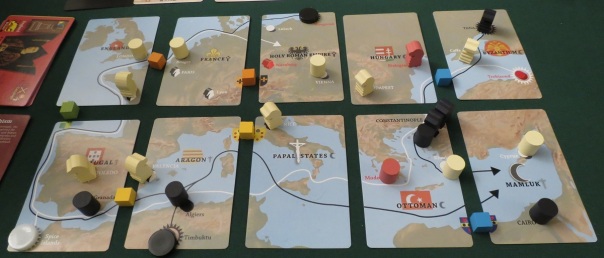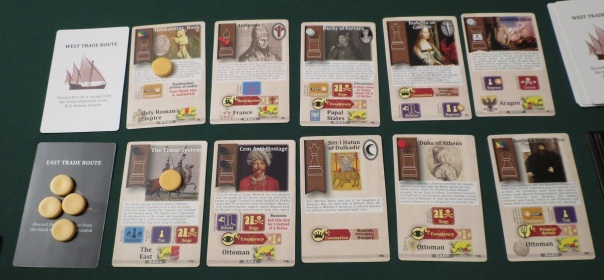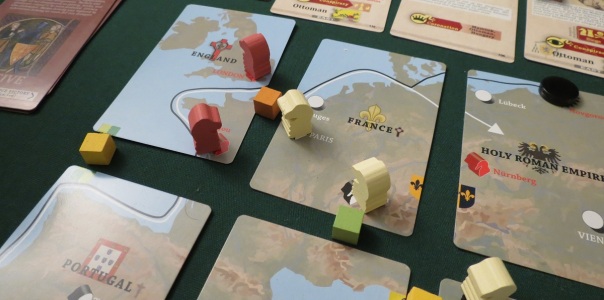Here I Stand II: Renaissance Gone Wild
Let’s say you’re making a game about the Renaissance. Not merely a slice of it. Not patronage of the arts, the rise of science, Florentine or Venetian city councils, Reformation and Counter-Reformation, trade routes and the tension between East and West, or the exploration of the New World. I mean all of it. The entire thing. The whole loaded ball of wax. Where do you start? Where do you finish? Perhaps most importantly, who are you, the player?
Pax Renaissance is a game with aspirations no less grand than capturing the entire ideological struggle of the Renaissance, the churn of ideas about religion, state, art, science, law, and every other little thing that produced Western culture as we now see it. Which isn’t actually all that surprising, given its pedigree. Both Pax Porfiriana and Pax Pamir were ambitious games as well, functioning as statements and simulations and playthings with equal mettle. This is the broadest topic yet for the Pax series, however, and it wouldn’t be hard to imagine the entire thing going up in flames as surely as Girolamo Savonarola’s attempt at governing Florence.
And yet, while Pax Renaissance is forced to make a few compromises in service of its gameplay, the final result is nothing short of a triumph.
There are two major questions that stab at the heart of Pax Renaissance. The first is, “Who are you?” The second, “What are you doing?”
That first question results in perhaps the game’s most significant trade-off. You have to be somebody, after all. And yet it’s a more robust question than it first appears. Should you be a king, in an era when the power of kings was in flux? Or perhaps a city council, when their reach into the wider world was often starkly limited? The head of a religious movement, in a time of spreading secularism and curiosity about the natural world? A trader or explorer, limited to their narrow vision? None of these answers seems sufficient, not when you need to be able to reach your fingers into every aspect of rule, religion, and culture from England to the depths of the Black Sea.
The answer, then, is a bit of a stretch, though it certainly fits what many folks will probably recall from being forced to read excerpts of The Prince in high school and punching Rodrigo Borgia in the nose in Assassin’s Creed II. Rather than taking center stage as a sovereign, for the third time the Pax series casts you as a middleman. Where Porfiriana pressed you between the pages as a land-owning hacendado under the rule of Porfirio Diaz, and Pamir as an Afghan warlord with a vision for how to shape your country, here you’re a Renaissance banker, doing your best to spread your investments and make a place for yourself in a rapidly-changing world.
It’s very Illuminati, and in a time that predates Adam Weishaupt’s Bavarian lodge by at least a solid century. The benefits, however, are tremendous. Arrayed before you on the table is the world near and far, dotted with rulers, warriors, and the middle and serf classes. Brilliantly, these are represented by chess pieces, which instantly lends the game a swiftly-legible visual language, and it’s not much more of a stretch to learn that the white pieces represent Catholicism, red are Reformists, and black stand in for Islam. Placed as you are at the helm of a vast family fortune like that of the Medici, it’s up to you to arrange marriages, support the arts, and even manipulate the ideological fabric of the world.
What you’ll be doing is broader question, in part because it’s kicked back with another: What do you want to do?
See, the goal of Pax Renaissance is nothing less than to determine the ideological fate of the world. Note that I’m not saying the religious fate, just as I’m not saying the national fate. The goal is singularly ideological, and this is one of those rare specimens that understands that sometimes religion or state matter a whole lot, while at other times they’re worth less than a bale of rotten straw. Sometimes you’ll be deeply invested in a cause — say, the ongoing Reformation in England and hopefully a push into France and the Holy Roman Empire. At that same instant, an opposing bank might be more interested in seeing the ruling classes of the H.R.E. remain as stable as possible, and in a cute moment of Cuius regio, eius religio, won’t give a fart for which cloud-wizard anyone within their holdings is praying to.
For the most part, the way it plays isn’t too far off from its predecessors. Much of the game’s tempo and strategy revolve around making smart picks from its ever-changing market, though this is more loaded than ever thanks to the way the market causes new trade opportunities to spring up around the map. There are two major routes at any given time, one dominated by the East and one by the West. As a bank, your most immediate goal is to profit from these routes, putting yourself in the path of the ships and caravans that will be hauling gold, spices, and slaves in one direction or the other. There are other ways to earn coin, but there’s nothing quite like having a hand in every pocket between Novgorod and Cairo.
Enter the concession, your main means of profiting from the map. While the independent nobility and knights are only ever indirectly under your command, nudged around with a card action and sometimes a bit of funding, the little colored cubes placed on map borders are entirely yours, and will merrily collect florins from passing trade fairs and help you gain majority votes in any local elections. Unfortunately, these little guys are easily removed by jealous opponents, often becoming the repressed classes who might one day rise up in a peasant’s rebellion. In order to protect your investments, you’re encouraged to help out regional kings, emperors, and sultans, gaining their ear when you help them find suitable mates or fund one of their wars. Of course, once you have them in your pocket, you can prompt them to invade their neighbors, thus spreading your influence and concessions. Or, even cooler, maybe you’ll spring one of those rebellions on them, usurping their power in favor of a brand new republic. Or launch a holy war and plunge the country into theocratic rule.
There’s a lot to consider, is what I’m saying. This is the sort of sprawling sandbox game where it can take a couple plays before you can expect to have a solid handle on what’s going on. But once it clicks, everything slides together like a jigsaw, leaving you free to pursue multiple goals in various regions across Europe and the Mediterranean.
Perhaps the purest expression of Pax Renaissance’s glorious sandboxy nature is the fact that there are five totally different win conditions. And I mean totally different.
Just to give you a sense of scale, in Pax Pamir your goal was twofold. First you had to prop one of three empires to supremacy, then ensure you were the most influential warlord within that empire. Not too bad.
In Pax Renaissance’s “Holy” victory, your goal is largely the same. You’ll have to win a few holy wars to secure some theocracies, prop up your chosen religion until it dominates the others, and then be the guy in charge of the movement. Maybe you’ll unify half the known world under Islam, or secure a northern Europe free of Catholicism. The point is, this one victory condition is nearly the equivalent of Pax Pamir’s entire victory state. There will be intrigue in the form of bishops doing your dirty work, entire military campaigns to rid the world of opposing viewpoints, and strict control over your theocracies. The entire game could be built around this single option.
And yet there are others. Instead, you might become the Charles V of your living room, stitching together an unbeatable empire of suzerains and vassals, and employing military might to exterminate any opposition. Or perhaps you’ll transform your own empires into wealthy republics, ensuring the spread of law and reason in place of superstition or national loyalties. Or crud, just embrace your role as a prototype shadow government and become the biggest banking institution the world has ever seen, complete with a firm grip on all the gold pouring in from the New World.
Each approach has its advantages and pratfalls. For one thing, there’s very little chance of claiming victory early in the game. Instead, you’ll have to wait for a comet to appear from one of the two market decks. Then, and only then, you’ll be able to “activate” one of the game’s objectives, making it available to everyone and signalling your intent. Of course, shrewd bankers will always keep irons in more than one fire. Watching as everybody joins together to dismantle your previously-untouchable empire, only to change directions and win by another means is one of the best feelings in board games this year.
In more ways than one, Pax Renaissance is every bit as shrewd as its bankers. In one recent game, I married into control of Byzantium, only to deliberately repress my lower classes, building resentment and frustration year after year while using Janissary mercenaries to slowly erode the nobility. At last, the Crim Horde appeared and struck a deal with me to liberate these oppressed serfs. Just like that, the flabby Byzantine Empire was replaced by a republic. Over the years, I shepherded this young state, funding vast wars in the west as a distraction from its weakened borders. Gutenberg and that goofball Savonarola provided my people with a respect for the law, which was enough to claim victory in a totally unique way when that first comet streaked across the night sky.
And it was exhilarating. Like so many of the processes in this game, it was as fluid as it was breathtaking. Wheels within wheels, plots that had sub-plots, player drama that arose once someone realized I was on the cusp on winning. There were trade disputes, mercenary clashes, religious squabbles between bishops…
That’s Pax Renaissance in a nutshell. In spite of a bit of historical flimflam, this is the sort of game that understands that power is derived from many places at once, that all these myriad ideas of governance and religion and aesthetics are bound up with one another, and that much of our current culture was developed across these few small centuries through violent conflict as much as through art or science or law. It’s smart like that.
And as a sandbox experience for those clever people who will take the time to learn its inner workings, it’s an unparalleled triumph.
Posted on December 8, 2016, in Board Game and tagged Board Games, Pax Renaissance, Phil Eklund, Sierra Madre Games. Bookmark the permalink. 25 Comments.
![In Old French, "Renaissance" translates roughly into "before [they] knew to look straight at the camera." In Old French, "Renaissance" translates roughly into "before [they] knew to look straight at the camera."](https://thurotdotcom.files.wordpress.com/2016/12/1-header-renaissance-which-is-kind-of-a-big-deal.jpg?w=604&h=240)




Sounds wonderful! The first two Pax games are some of my favorites thanks to your reviews, and I look forward to trying this one. At the same time, all those options sound intimidating. Is it significantly harder to learn and teach, or will veterans of the series feel somewhat comfortable?
Veterans will have a leg up in a couple areas. You’ll understand the market for the most part, and the cards use an action system not unlike the one in Pax Pamir. It takes the “three empires that you don’t directly control” thing from Pamir and expands it outwards, which is a little tricky to understand at first, but doesn’t take too long to click. The hardest part for me was repression — units can be shoved off the map and onto the empire cards, becoming the repressed classes who might emerge during a civil war. Very cool, though I had to see it in action before I understood what the fuss was about.
Fantastic review. I have a copy just recently arrived, and am very much looking forward to getting it to the table (more so now I have read your review)!
I hope you enjoy it!
Oh yes. So good. I’m satisfied that I’ve finally achieved a Reformist Holy victory. Chew on that, universal church!
I was *this* close to a reformist victory not too long ago. Some changes to the map put it out of reach — hence my Byzantine republic win!
Seven plays in and I am a big fan of this game. Are you planning on going to BryceCon 2017 by any chance? If you are, we should find a table and play this!
Hm, I hadn’t even been considering it, but maybe I ought to. That’s only four hours away!
Definitely look into it. It will be their 3rd year running and the previous two cons were great fun. This time around they announced a 250 cap on the number of attendees, but hopefully there is still some space left. Quite a number of folks from the SLC area attended the first two.
Thanks for the Pax reviews (and all others 😉 ). Do you plan to review Pax Renaissance expansion too ?
Maybe. My initial impression is that it adds some really nice stuff, but perhaps dilutes the deck a little too dramatically. For instance, you might never see a Reformist bishop at all with the expansion mixed in, which effectively nullifies an entire victory approach.
Then again, I haven’t played with it very much. There’s plenty in the vanilla deck to keep anybody occupied for a great many games. In order to review it, I’d have to play with it a few more times!
So, I’ve been eying Phil Eklund’s games for a while but never pulled the trigger, and have realized just how flighty an existence they can have. I’d love to get Pamir, but without it OOP and unknown when we’ll see a second, I’m considering grabbing Renaissance while it’s still on shelves–you’ve made it sound fairly compelling, so long as I can get it on the table.
Meanwhile I’ll be hunting for an elusive (and no doubt highly pricey) copy of High Frontier 3e, based on what I’ve heard and the fact that, well, I’m all about rockets and space.
There’s always that danger with small independent publishers, unfortunately. Especially one that makes such niche titles.
High Frontier 3e is apparently on its way to my doorstep, and I grow more agitated with every passing day that it doesn’t show up. Then again, I derive some minor satisfaction from imagining the look on a package-thief’s face when he pries the thing open.
That’s assuming he could lift it–sounds like it’s a real beast. Looking forward to hearing your thoughts! Hopefully I’ll be able to grab one myself. If not, maybe he’ll do another run eventually, perhaps with a different publisher.
Gonna look at the Bios Genesis KS when it goes up, as it sounds intriguing.
Best review I have read about this game. 🙂
Mighty kind of you to say!
Pingback: Here I Stand II: Renaissance Gone Wild - eJouer.info eJouer.info
Pingback: The Space-Biff! Space-Cast! Episode #7: Welcome to the Sandbox | SPACE-BIFF!
Pingback: Best Week 2016, Lessons! | SPACE-BIFF!
Pingback: From Soup to Seaweed | SPACE-BIFF!
Pingback: Bios: Mega-fun-a | SPACE-BIFF!
Pingback: A Handful of Excellent Sandbox Games | SPACE-BIFF!
Pingback: Going Medieval on Medieval | SPACE-BIFF!
Pingback: The Future of Pax, the Future of Us | SPACE-BIFF!
Pingback: Home for the Hollandays | SPACE-BIFF!